Preparation of Uniform-Sized and Dual Stimuli-Responsive Microspheres of Poly(N-Isopropylacrylamide)/Poly(Acrylic acid) with Semi-IPN Structure by One-Step Method
Abstract
:1. Introduction
2. Experimental Section
2.1. Materials
2.2. Synthesis of PAAc
2.3. Preparation of PNIPAM and Semi-IPN Microspheres
2.4. Characterizations of Microspheres
2.5. Measurement of Thermo- and pH-responsive Behaviors of Microspheres
2.6. Examination of Microsphere Stability
3. Results and Discussion
3.1. Optimization of the Process Parameters for Preparing Microspheres with a Narrow Size Distribution
3.1.1. Trans-Membrane Pressure
3.1.2. Number of Trans-Membrane Passes
3.2. Chemical Structure of the PNIPAM-PAAc Semi-IPN Microspheres
3.3. Particle Morphology and Size of the PNIPAM-PAAc Semi-IPN Microspheres
3.4. TEM Observation of PNIPAM-PAAc Semi-IPN Microspheres
3.5. DSC Thermograms of the PNIPAM–PAAc Semi-IPN Microspheres
3.6. Thermo- and pH-Responsive Behaviors of Microspheres
3.7. Storage Stability of Microspheres
4. Conclusions
Supplementary Materials
Acknowledgments
Author Contributions
Conflicts of Interest
References
- Gil, E.; Hudson, S. Stimuli-reponsive polymers and their bioconjugates. Prog. Polym. Sci. 2004, 29, 1173–1222. [Google Scholar] [CrossRef]
- Ono, Y.; Shikata, T. Hydration and dynamic behavior of poly(N-isopropylacrylamide)s in aqueous solution. J. Am. Chem. Soc. 2006, 128, 10030–10031. [Google Scholar] [CrossRef] [PubMed]
- Pinheiro, J.P.; Moura, L.; Fokkink, R.; Farinha, J.P. Preparation and characterization of low dispersity anionic multiresponsive core-shell polymer nanoparticles. Langmuir 2012, 28, 5802–5809. [Google Scholar] [CrossRef] [PubMed]
- Hendrickson, G.R.; Smith, M.H.; South, A.B.; Lyon, L.A. Design of multiresponsive hydrogel particles and assemblies. Adv. Funct. Mater. 2010, 20, 1697–1712. [Google Scholar] [CrossRef]
- Thorne, J.B.; Vine, G.J.; Snowden, M.J. Microgel applications and commercial considerations. Colloid. Polym. Sci. 2011, 289, 625–646. [Google Scholar] [CrossRef]
- Welsch, N.; Becker, A.L.; Dzubiella, J.; Ballauff, M. Core–shell microgels as “smart” carriers for enzymes. Soft Matter 2012, 8, 1428–1436. [Google Scholar] [CrossRef]
- Wu, Q.; Su, T.; Mao, Y.; Wang, Q. Thermal responsive microgels as recyclable carriers to immobilize active proteins with enhanced nonaqueous biocatalytic performance. Chem. Commun. 2013, 49, 11299–11301. [Google Scholar] [CrossRef] [PubMed]
- Kawaguchi, H. Thermoresponsive microhydrogels: Preparation, properties and applications. Polym. Int. 2014, 63, 925–932. [Google Scholar] [CrossRef]
- Kratz, K.; Hellweg, T.; Eimer, W. Influence of charge density on the swelling of colloidal poly(N-isopropylacrylamide-co-acrylic acid) microgels. Colloids Surf. A 2000, 170, 137–149. [Google Scholar] [CrossRef]
- Burmistrova, A.; Richter, M.; Eisele, M.; Üzüm, C.; von Klitzing, R. The effect of co-monomer content on the swelling/shrinking and mechanical behaviour of individually adsorbed PNIPAM microgel particles. Polymers 2011, 3, 1575–1590. [Google Scholar] [CrossRef]
- Si, T.; Wang, Y.; Wei, W.; Lv, P.; Ma, G.; Su, Z. Effect of acrylic acid weight percentage on the pore size in poly(N-isopropylacrylamide-co-acrylic acid) microspheres. React. Funct. Polym. 2011, 71, 728–735. [Google Scholar] [CrossRef]
- Li, Z.; Shen, J.; Ma, H.; Lu, X.; Shi, M.; Li, N.; Ye, M. Preparation and characterization of sodium alginate/poly(N-isopropylacrylamide)/clay semi-IPN magnetic hydrogels. Polym. Bull. 2012, 68, 1153–1169. [Google Scholar] [CrossRef]
- Hoare, T.; Pelton, R. Highly pH and temperature responsive microgels functionalized with vinylacetic acid. Macromolecules 2004, 37, 2544–2550. [Google Scholar] [CrossRef]
- Koul, V.; Mohamed, R.; Kuckling, D.; Adler, H.J.; Choudhary, V. Interpenetrating polymer network (IPN) nanogels based on gelatin and poly(acrylic acid) by inverse miniemulsion technique: Synthesis and characterization. Colloids Surf. B 2011, 83, 204–213. [Google Scholar] [CrossRef] [PubMed]
- Berger, J.; Reist, M.; Mayer, J.M.; Felt, O.; Peppas, N.A.; Gurny, R. Structure and interactions in covalently and ionically crosslinked chitosan hydrogels for biomedical applications. Eur. J. Pharm. Biopharm. 2004, 57, 19–34. [Google Scholar] [CrossRef]
- Lipatov, Y.S.; Alekseeva, T.T. Phase-separated interpenetrating polymer networks. Adv. Polym. Sci. 2007, 208, 1–227. [Google Scholar]
- Xia, X.; Hu, Z. Synthesis and light scattering study of microgels with interpenetrating polymer networks. Langmuir 2004, 20, 2094–2098. [Google Scholar] [CrossRef] [PubMed]
- Hu, Z.; Xia, X. Hydrogel nanoparticle dispersions with inverse thermoreversible gelation. Adv. Mater. 2004, 16, 305–309. [Google Scholar] [CrossRef]
- Ma, J.; Fan, B.; Liang, B.; Xu, J. Synthesis and characterization of poly(N-isopropylacrylamide)/poly(acrylic acid) semi-IPN nanocomposite microgels. J. Colloid Interf. Sci. 2010, 341, 88–93. [Google Scholar] [CrossRef] [PubMed]
- Xing, Z.; Wang, C.; Yan, J.; Zhang, L.; Li, L.; Zha, L. pH/Temperature dual stimuli-responsive microcapsules with interpenetrating polymer network structure. Colloid. Polym. Sci. 2010, 288, 1723–1729. [Google Scholar] [CrossRef]
- Xing, Z.; Wang, C.; Yan, J.; Zhang, L.; Li, L.; Zha, L. Dual stimuli responsive hollow nanogels with IPN structure for temperature controlling drug loading and pH triggering drug release. Soft Matter 2011, 7, 7992–7997. [Google Scholar] [CrossRef]
- Ahmad, H.; Nurunnabi, M.; Rahman, M.M.; Kumar, K.; Tauer, K.; Minami, H.; Gafur, M.A. Magnetically doped multi stimuli-responsive hydrogel microspheres with IPN structure and application in dye removal. Colloids Surf. A 2014, 459, 39–47. [Google Scholar] [CrossRef]
- Jones, C.D.; Lyon, L.A. Synthesis and characterization of multiresponsive core-shell microgels. Macromolecules 2000, 33, 8301–8306. [Google Scholar] [CrossRef]
- Nilsson, C.; Birnbaum, S.; Nilsson, S. Nanoparticle-based pseudostationary phases in CEC: A breakthrough in protein analysis? Electrophoresis 2011, 32, 1141–1147. [Google Scholar] [CrossRef] [PubMed]
- Kwok, M.-H.; Li, Z.-F.; Ngai, T. Controlling the synthesis and characterization of micrometer-sized PNIPAM microgels with tailored morphologies. Langmuir 2013, 29, 9581–9591. [Google Scholar] [CrossRef] [PubMed]
- Ma, G.-H.; Sone, H.; Omi, S. Preparation of uniform-sized polystyrene–polyacrylamide composite microspheres from a wow emulsion by membrane emulsification. Macromolecules 2004, 37, 2954–2964. [Google Scholar] [CrossRef]
- Wei, Y.; Wang, Y.-X.; Wang, W.; Ho, S.V.; Wei, W.; Ma, G.-H. mPEG–PLA microspheres with narrow size distribution increase the controlled release effect of recombinant human growth hormone. J. Mater. Chem. 2011, 21, 12691–12699. [Google Scholar] [CrossRef]
- Wang, Y.-X.; Qin, J.; Wei, Y.; Li, C.-P.; Ma, G.-H. Preparation strategies of thermo-sensitive P(NIPAM-co-AA) microspheres with narrow size distribution. Powder Technol. 2013, 236, 107–113. [Google Scholar] [CrossRef]
- Ma, G.-H. Microencapsulation of protein drugs for drug delivery: Strategy, preparation, and applications. J. Control Release 2014, 193, 324–340. [Google Scholar] [CrossRef] [PubMed]
- Myung, D.; Koh, W.; Ko, J.; Hu, Y.; Carrasco, M.; Noolandi, J.; Ta, C.N.; Frank, C.W. Biomimetic strain hardening in interpenetrating polymer network hydrogels. Polymer 2007, 48, 5376–5387. [Google Scholar] [CrossRef]
- Qi, F.; Wu, J.; Fan, Q.-Z.; He, F.; Tian, G.-F.; Yang, T.Y.; Ma, G.-H.; Su, Z.-G. Preparation of uniform-sized exenatide-loaded PLGA microspheres as long-effective release system with high encapsulation efficiency and bio-stability. Colloid. Surface B 2013, 112, 492–498. [Google Scholar] [CrossRef] [PubMed]
- Fuminori, I.; Kimiko, M. Preparation and properties of monodispersed rifampicin-loaded poly(lactide-co-glycolide) microspheres. Colloids Surfaces B Biointerf. 2004, 39, 17–21. [Google Scholar]
- Arash, K.; Rassoul, K. Effect of Alyssum homolocarpum seed gum, Tween 80 and NaCl on droplets characteristics, flow properties and physical stability of ultrasonically prepared corn oil-in-water emulsions. Food Hydrocolloids 2011, 25, 1149–1157. [Google Scholar]
- Ma, G.-H.; Yang, J.; Lv, P.-P.; Wang, L.-Y.; Wei, W.; Tian, R.; Wu, J.; Su, Z.-G. Preparation of uniform microspheres and microcapsules by modified emulsification process. Macromol. Symp. 2010, 288, 41–48. [Google Scholar] [CrossRef]
- Xiao, X.; Zhuo, R.; Xu, J.; Chen, L. Effects of reaction temperature and reaction time on positive thermosensitivity of microspheres with poly(acrylamide)/poly(acrylic acid) IPN shells. Eur. Polym. J. 2006, 42, 473–478. [Google Scholar] [CrossRef]
- Burillo, G.; Briones, M.; Adem, E. IPN’s of acrylic acid and N-isopropylacrylamide by gamma and electron beam irradiation. Nucl. Instrum. Methods Phys. Res. Sect. B 2007, 265, 104–108. [Google Scholar] [CrossRef]
- Djonlagi, J.; Petrovi, Z.S. Semi-interpenetrating polymer networks composed of poly(N-isopropyl acrylamide) and polyacrylamide hydrogels. J. Polym. Sci. Part B 2004, 42, 3987–3999. [Google Scholar] [CrossRef]
- Zhao, S.-P.; Ma, D.; Zhang, L.-M. New semi-interpenetrating network hydrogels: Synthesis, characterization and properties. Macromol. Biosci. 2006, 6, 445–451. [Google Scholar] [CrossRef] [PubMed]
- Potorac, S.; Popa, M.; Verestiuc, L.; le Cerf, D. New semi-IPN scaffolds based on HEMA and collagen modified with itaconic anhydride. Mater. Lett. 2012, 67, 95–98. [Google Scholar] [CrossRef]
- Williams, R.A.; Peng, S.J.; Wheeler, D.A.; Morley, N.C.; Taylor, D.; Whalley, M.; Houldsworth, D.W. Controlled production of emulsions using a crossflow membrane. Chem. Eng. Res. Des. 1998, 76, 902–910. [Google Scholar] [CrossRef]
- Mariana, P.-H.; Richard, G.-H. Membrane emulsification for the production of uniform poly-N-isopropylacrylamide-coated alginate particles using internal gelation. Chem. Eng. Res. Des. 2014, 92, 1664–1673. [Google Scholar]
- John, J.; Klepac, D.; Didović, M.; Sandesh, C.J.; Liu, Y.; Raju, K.V.S.N.; Pius, A.; Valić, S.; Thomas, S. Main chain and segmental dynamics of semi interpenetrating polymer networks based on polyisoprene and poly(methyl methacrylate). Polymer 2010, 51, 2390–2402. [Google Scholar] [CrossRef]
- Liu, T.-Y.; Lin, W.-C.; Huang, L.-Y.; Chen, S.-Y.; Yang, M.-C. Surface characteristics and hemocompatibility of PAN/PVDF blend membranes. Polym. Adv. Technol. 2005, 16, 413–419. [Google Scholar] [CrossRef]
- Thimma Reddy, T.; Takahara, A. Simultaneous and sequential micro-porous semi-interpenetrating polymer network hydrogel films for drug delivery and wound dressing applications. Polymer 2009, 50, 3537–3546. [Google Scholar] [CrossRef]
- Fundueanu, G.; Constantin, M.; Asmarandei, I.; Bucatariu, S.; Harabagiu, V.; Ascenzi, P.; Simionescu, B.C. Poly(N-isopropylacrylamide-co-hydroxyethylacrylamide) thermosensitive microspheres: The size of microgels dictates the pulsatile release mechanism. Eur. J. Pharm. Biopharm. 2013, 85, 614–623. [Google Scholar] [CrossRef] [PubMed]
- Khan, A. Preparation and characterization of N-isopropylacrylamide/acrylic acid copolymer core-shell microgel particles. J. Colloid Interface Sci. 2007, 313, 697–704. [Google Scholar] [CrossRef] [PubMed]
- Liu, X.-Y.; Guo, H.; Zha, L.-S. Study of pH/temperature dual stimuli-responsive nanogels with interpenetrating polymer network structure. Polym. Int. 2012, 61, 1144–1150. [Google Scholar] [CrossRef]
- Chen, Y.; Ding, D.; Mao, Z.; He, Y.; Hu, Y.; Wu, W.; Jiang, X. Synthesis of hydroxypropylcellulose-poly(acrylic acid) particles with semi-interpenetrating polymer network structure. Biomacromolecules 2008, 9, 2609–2614. [Google Scholar] [CrossRef] [PubMed]
- Myung, D.; Waters, D.; Wiseman, M.; Duhamel, P.; Noolandi, J.; Ta, C.N.; Frank, C.W. Progress in the development of interpenetrating polymer network hydrogels. Polym. Adv. Technol. 2008, 19, 647–657. [Google Scholar] [CrossRef] [PubMed]


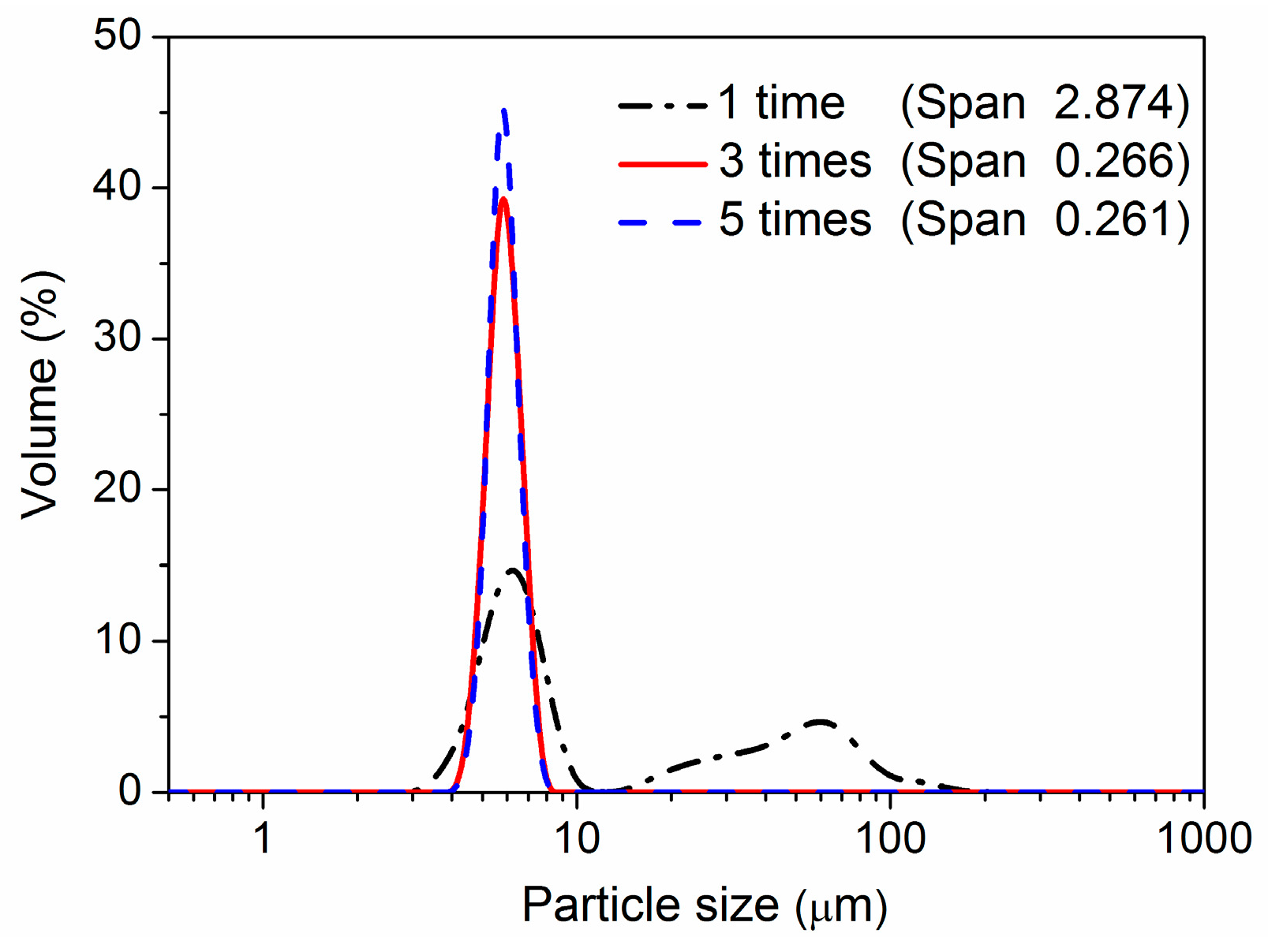
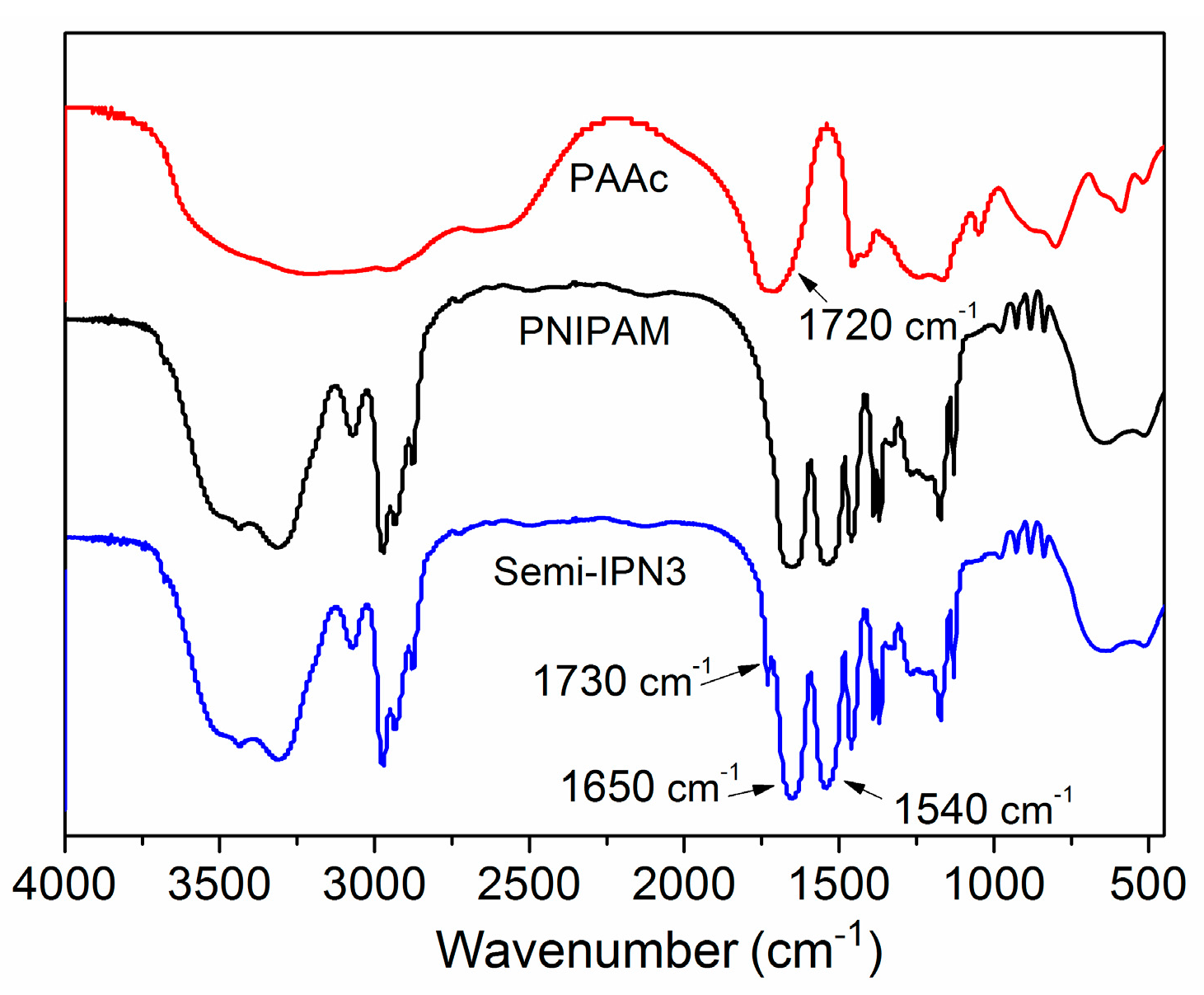
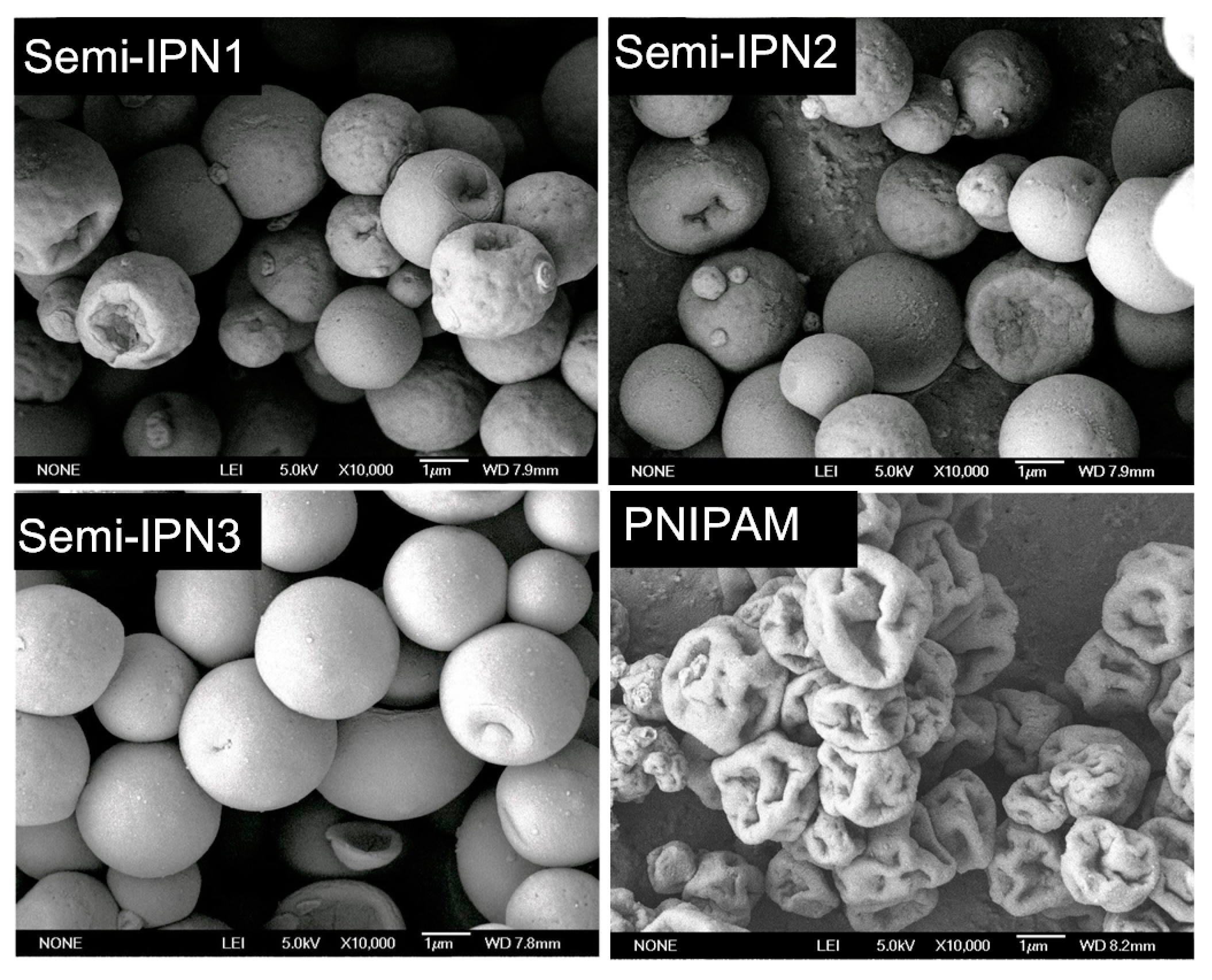

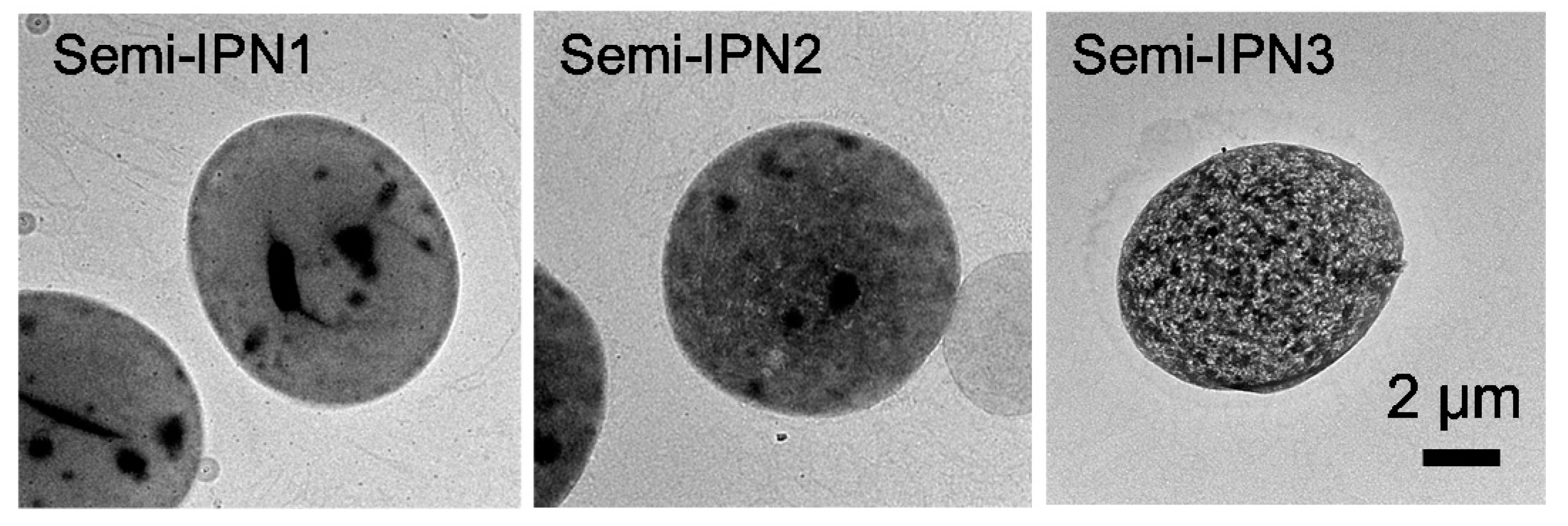
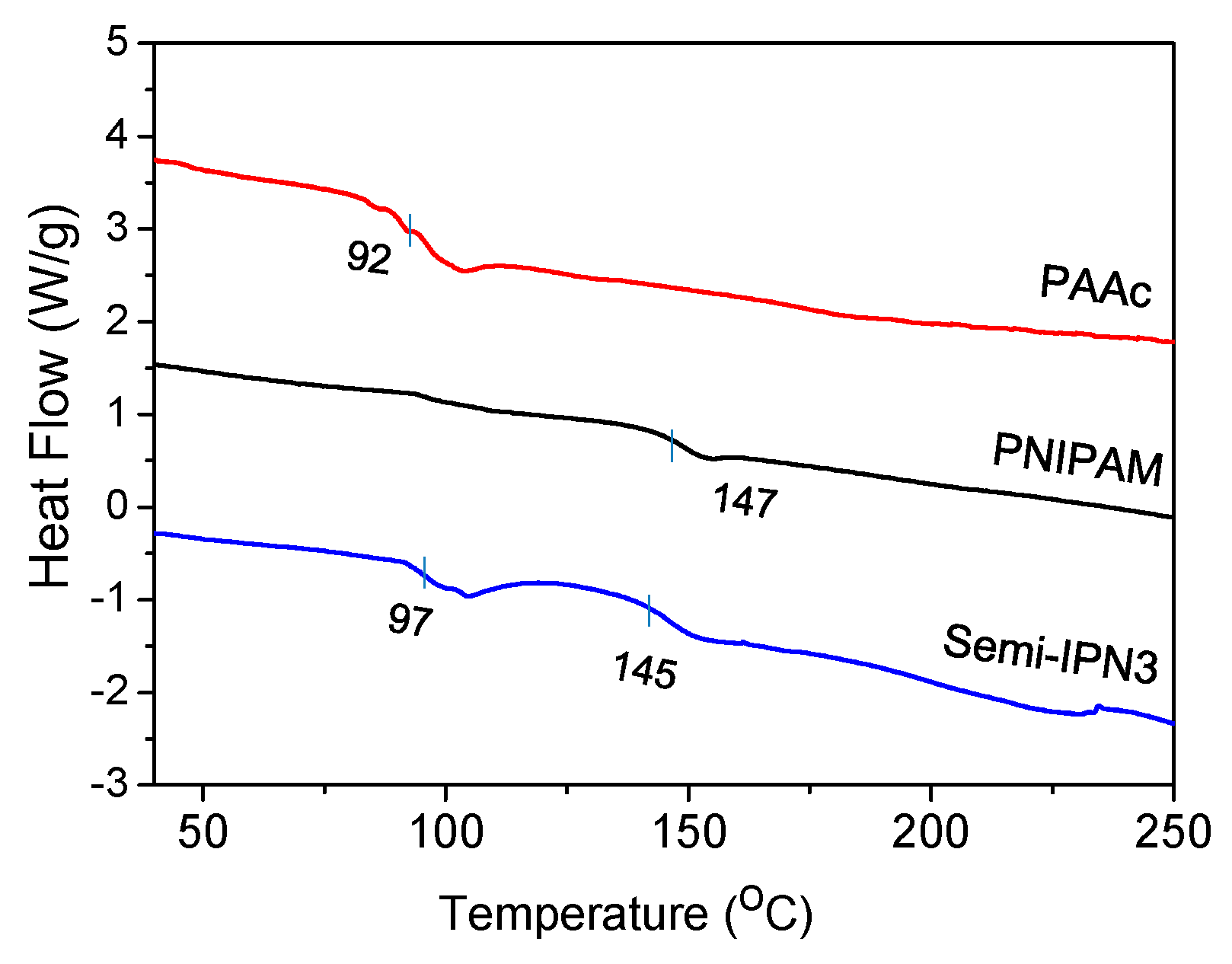


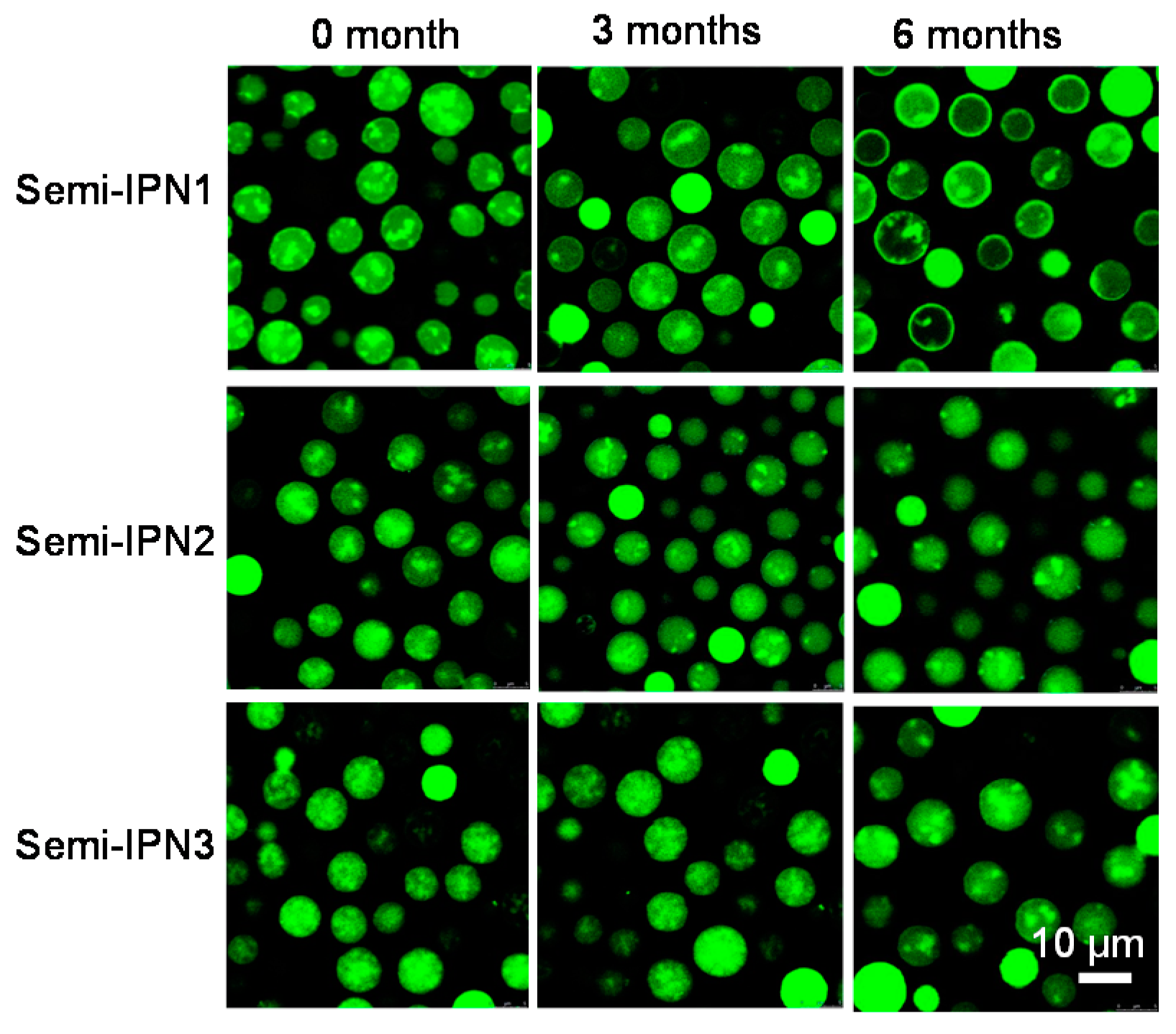
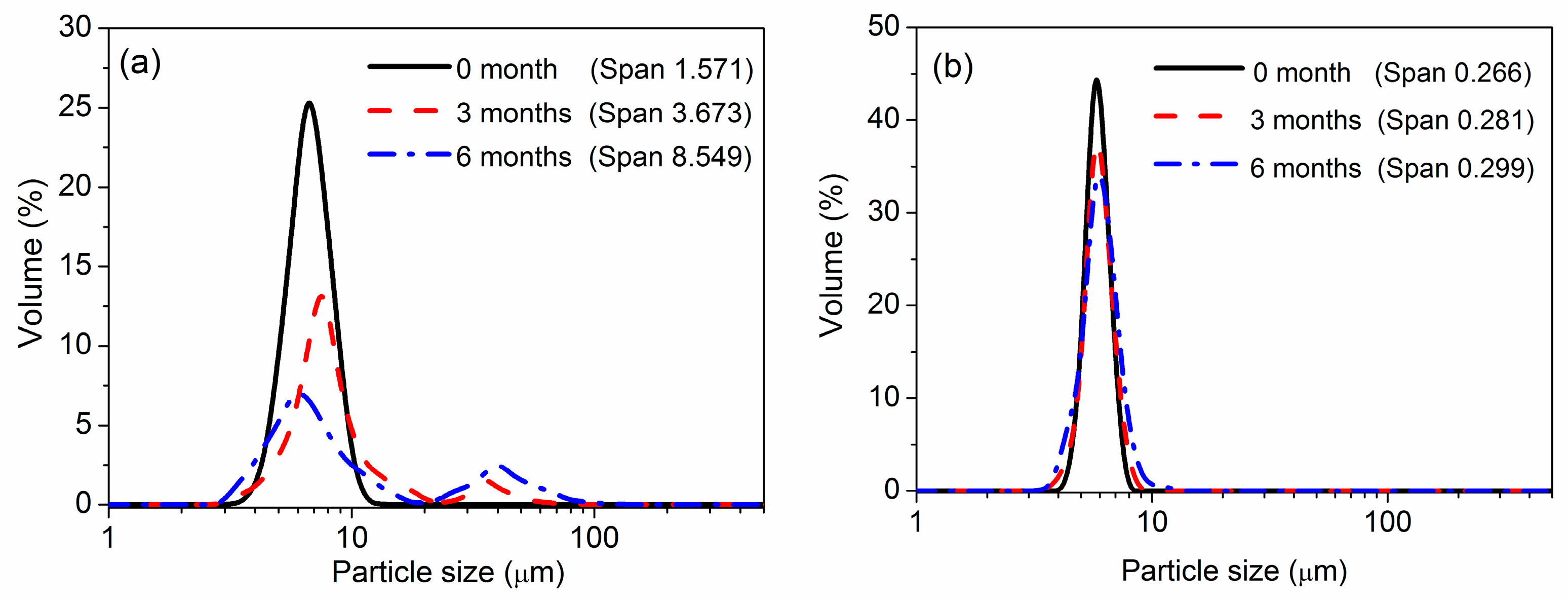
| Sample Code | NIPAM (×10−1 mol/L) | PAAc (×10−5 mol/L) | MBA (×10−2 mol/L) | APS (×10−2 mol/L) | TEMED (×10−3 mol) |
|---|---|---|---|---|---|
| PNIPAM | 7.1 | 0 | 3.2 | 1.1 | 6.7 |
| semi-IPN1 | 7.1 | 3.4 | 3.2 | 1.1 | 6.7 |
| semi-IPN2 | 7.1 | 3.4 | 3.2 | 2.2 | 13.4 |
| semi-IPN3 | 7.1 | 3.4 | 3.2 | 3.3 | 20.1 |
| Sample | Particle Size (μm) | Span |
|---|---|---|
| PNIPAM | 6.5 ± 1.7 | 1.571 ± 0.500 |
| Semi-IPN1 | 6.7 ± 2.5 | 0.649 ± 0.219 |
| Semi-IPN2 | 6.3 ± 1.1 | 0.272 ± 0.132 |
| Semi-IPN3 | 6.2 ± 0.7 | 0.266 ± 0.112 |
© 2016 by the authors. Licensee MDPI, Basel, Switzerland. This article is an open access article distributed under the terms and conditions of the Creative Commons by Attribution (CC-BY) license ( http://creativecommons.org/licenses/by/4.0/).
Share and Cite
Lai, E.-P.; Wang, Y.-X.; Wei, Y.; Li, G. Preparation of Uniform-Sized and Dual Stimuli-Responsive Microspheres of Poly(N-Isopropylacrylamide)/Poly(Acrylic acid) with Semi-IPN Structure by One-Step Method. Polymers 2016, 8, 90. https://doi.org/10.3390/polym8030090
Lai E-P, Wang Y-X, Wei Y, Li G. Preparation of Uniform-Sized and Dual Stimuli-Responsive Microspheres of Poly(N-Isopropylacrylamide)/Poly(Acrylic acid) with Semi-IPN Structure by One-Step Method. Polymers. 2016; 8(3):90. https://doi.org/10.3390/polym8030090
Chicago/Turabian StyleLai, En-Ping, Yu-Xia Wang, Yi Wei, and Guang Li. 2016. "Preparation of Uniform-Sized and Dual Stimuli-Responsive Microspheres of Poly(N-Isopropylacrylamide)/Poly(Acrylic acid) with Semi-IPN Structure by One-Step Method" Polymers 8, no. 3: 90. https://doi.org/10.3390/polym8030090






